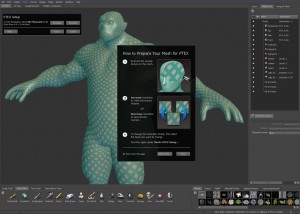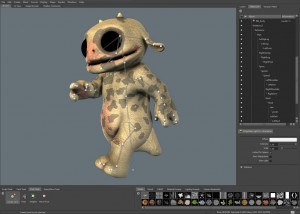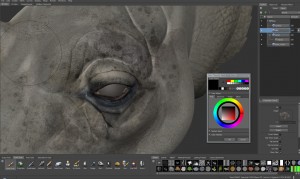By Mike de la Flor
Reaping the benefits of a developmental fast track Mudbox 2012 bears the fruit of five years of successful development by Autodesk. As a result Mudbox 2012 ships with an even better 3D paint system, better posing, new sculpting options, interface improvements, and critical performance updates.
Photoshop-like 3D Painting
Though Mudbox 2011 introduced important new features to the 3D paint system Mudbox 2012 goes above and beyond with support for Per-face texturing (Ptex) and new layer masks and blending modes. Developed by Disney Studios, Ptex is a novel, open source, texturing/mapping method that does not use UVs. Unlike UV mapping Ptex assigns texture data to each face (polygon) on a model, thus no UV data is required. Further, different faces can have varying resolutions and Ptex files can hold different texture maps like ambient occlusion, displacement or normal maps.

With Per-face texturing (Ptex) it is now possible to paint detailed textures without UVs. (Click to enlarge)
To get started using Ptex in Mudbox simply run the PTEX Set Up command select the texture resolution and start painting. All painting tools and brushes and paint layers work the same as if working with UVs. The downside is that PTex files are not really editable in programs like Photoshop.The layers in Mudbox 2012 now have layer masks and 22 new blending modes. If you know Phothoshop (or any other image editing program) then you will feel right at home with Mudbox’s new layer features. The best thing about the new layer masks and blending modes is that much of the work that would have been done by exporting textures to Photoshop can now be done entirely in Mudbox. Also new with the paint layers is Solo. This feature quickly isolates the contents of one layer for easier editing.
Overall Mudbox’s 3D paint system is top-notch and easily outshines the competition because of its ease-of-use and its comprehensive array of paint brushes and tools. The best thing about Mudbox’s 3D paint system is that it has a standard interface and resembles Photoshop, so a new user does not have to learn yet another paint workflow. The only thing to complain about is that Mudbox does not have any practical UV tools. While competitors like ZBrush and 3DCoat feature UV editing tools.

It is now possible to completely rig a model for better posing, though there are some annoying bugs. (Click to enlarge)
Better Posing?
The ability to pose a model during sculpting is an important part of the design process. However, previous versions of Mudbox sorely lacked any real posing tools, but Mudbox 2012 delivers a more complete joint and posing system. In this release it is now possible to create multiple joints connected by bones, so theoretically it is should be possible to completely rig, weight, and pose an entire model. However, if weighting is not done correctly sometimes joints end up being parented to the wrong bone. Fortunately, Mudbox can import models that are fully rigged from applications like Maya and 3ds Max or any application that can export in the FBX format. Also new in the posing department is Pose Presets, this option allows artist to save various poses and apply them later. While Mudbox’s new posing tools are a huge improvement over previous versions there is still a bit quirkiness in the system that sometimes causes unexpected results.
Improved Sculpting Workflow
While Mudbox 2010 introduced many new sculpting brushes and Mudbox 2011 added a few more tools and options, Mudbox 2012 adds only a couple of options to the Grab brush. Well, that’s better than nothing, but on the bright side the sculpting workflow has been improved with new options. First in the line up are editable stencils. Stencils can now be edited in real time with various brushes to make them conform models better which is very cool. Next, the new Transfer Details option allows artists to import a model that has been changed in an external application and transfer sculpting data to the imported model. This is part of Mudbox’s better interoperability with Maya and 3ds Max. Last, a sure favorite is the new Rebuild Subdivision Levels which will restore subdivision levels to dense model, making it possible to sculpt in the appropriate sub-D level on an
Smooth Performer
Working under the hood Autodesk has improved Mudbox’s ability to load, display, edit, and save massive texture datasets . Mudbox can better manage huge, imported models with tens of millions of polys and native subdivisions for faster, smoother display and editing. These performance enhancements make Mudbox a more efficient, more stable digital sculpting and 3D painting platform.
Streamlined Look
To provide artists with a better working environment Mudbox 2012 has new Maya-like heads-up displays. The new hot-box invoked by pressing the space bar displays icons for the main sections of Mudbox like sculpting, painting, or selections. And now right-clicking over a model or the scene displays contextual menus with common options. Also new are lasso and marquee selection options for the Freeze, Weights, and Selection tools. While the new improvements welcomed, Autodesk needs to work on the Objects list so that it conforms better to other Mubox lists. The Objects list does not allow users to move or group objects and it does not have a contextual menu.
With Mudbox there’s no quirky interface or steep learning curve to contend with. Someone familiar with Maya, Max, Cinema 4D, (etc.) will quickly get their heads around Mudbox’s workflows and someone familiar with Photoshop will easily see the logic behind Mudbox’s paint system, freeing up the artist to create. Mudbox 2012 only adds to the already unmatched sculpting and painting tool with Ptex support, new layer masks and blending modes, updated posing tools, new sculpting options and workflow, and tuned computing performance. At $745 USD for a new license or $345 USD for an upgrade Mudbox is a bit pricey when compared to ZBrush or 3DCoat. However, Mudbox features tools and workflows not found in its competition including one-click interoperability with applications like Max, Maya, SoftImage, and Photoshop.
Rating:Sweet
Developer: Autodesk www.autodesk.com
Platform: Windows and Macintosh
Cost: $795, Upgrade $395


[title size="2" content_align="left" style_type="default"]Leave A Comment[/title]